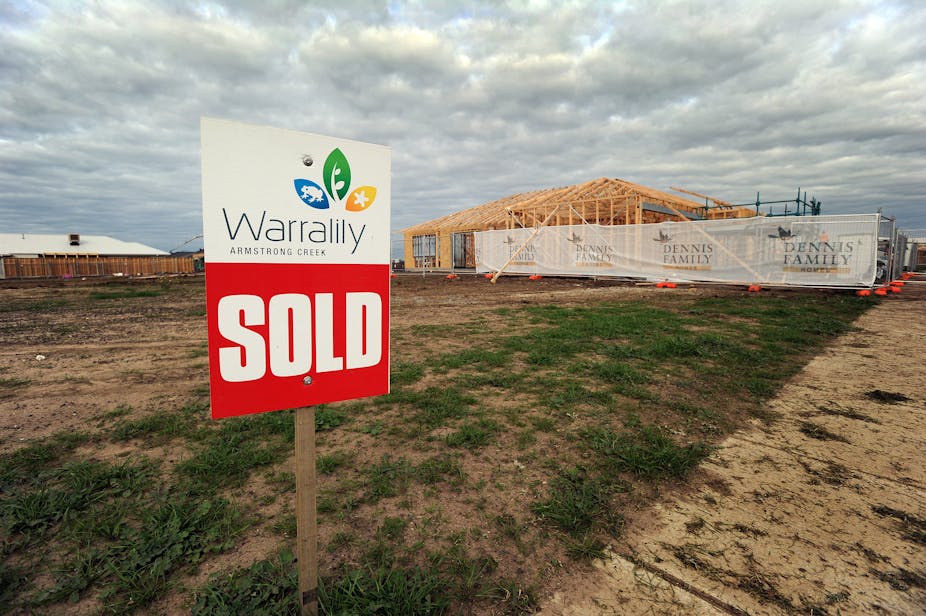State government attempts to redirect development from urban fringes to established urban areas have failed.
New deregulated planning systems, not strategic metropolitan plans, are driving development. Governments have released large amounts of greenfield land, abandoning urban growth boundaries. This has led to an increased proportion of outer urban growth in some capital cities. In Melbourne, 50% of the approximately 40,000 new dwellings annually are built in new greenfield sites, instead of the 2002 target of 30%.
Another consequence is that Australian cities are becoming taller. Residential apartment blocks now dominate multi-unit construction in many cities. High and medium rise dwelling construction in Melbourne, at about 14,000 approvals annually, is up to double that of medium density housing, almost all constructed in the central business district and inner suburbs.
There is a growing mismatch between emerging housing preferences and the type of fringe and apartment housing being supplied. Many people in the large emerging 25-44 age group, in particular, are not going to buy either alternative. Large numbers will reject both poorly serviced, uniform, single use housing estates with their car based retailing and low local employment, or alternatively, small apartments in forests of residential towers at exorbitant prices.
On current trends, Sydney and Melbourne will grow to between 6-8 million people, and the greater Brisbane area and Perth will also house large populations. The first priority of governments should be to prevent such growth. But the current trends are the worst growth options.
High rise construction will destroy the capacity for inner urban areas to attract investment and innovators. Continued outer urban growth will condemn lower income groups to car based outer suburbs which will never gain proper standards of infrastructure, services or access to jobs while the well-off will segregate themselves into high amenity, service and job rich areas. None of this bodes well for the future of our cities.

Development interests have convinced governments that outer urban growth boundaries cause a shortage of developable land and raise land prices. The National Housing Supply Council helped create a sense of crisis, estimating the Australian housing shortage at 185,000 in 2011. This fictitious figure, belonging more to propaganda than fact, was given legitimacy in the 2012 Commonwealth State of Australian Cities report.
The attempt to link outer and established urban areas in a total estimate of land supply, and to reevaluate ways to increase urban density, brought down metropolitan strategies. Most outer urban development companies were unwilling to relocate their activities into established areas. Instead, they bought or optioned land outside the boundaries and pressured governments to shift the boundary.
Higher average housing densities greatly augment outer urban land supply. A yield of 20 dwellings per hectare saves up to 46% of land and increases lot yield by up to 60%. Denser, better planned and serviced new outer suburbs, and attached row housing and medium rise apartments as infill, are achievable alternatives to unregulated low density outer urban, and high rise housing. We should be emulating the best in European cities not the worst in Asian and American cities. Some inner area redevelopments have demonstrated a better way, for example, in East Perth and Subiaco, and Lynch’s Bridge in Melbourne.
Planning regulation is a small component of housing costs in urban areas. Land banking by development companies and home purchase subsidies led to much greater reductions in affordability. The failure of governments to require smaller outer urban lot sizes has prevented more diverse housing options forcing the most financially stressed consumers to buy large houses and bear high running costs. In established city areas, high labour and construction costs, land speculation and financial policies such as negative gearing have led to a combination of high apartment prices and declining unit sizes.
Claims are now being made that councils are restricting land supply in established urban areas by restricting higher density housing, thwarting the intent of developer-led planning systems. But large land supplies are available in the established areas of most Australian cities.
Regulatory protection for inner and middle ring heritage housing and shops will have little impact on the scale of urban redevelopment. In Australian cities, further redevelopment will occur in and near commercial areas, large-scale redevelopment areas including nominated brownfield and transit oriented sites. Cities can be connected to regional centres. A huge stock of diverse smaller infill sites exists in most cities. Large amounts of post-1945 suburban land will be available for medium density redevelopment particularly near rail stations outside the inner and middle ring areas.
Powerful interests are using facilitative, market based land use systems to further their own short-term interests. Only governments can plan for the broader public interest and achieve properly functioning cities. Scare tactics about alleged shortages of land and housing have furthered sectional advantage, not the public interest. Governments urgently need to rethink housing options and ways to achieve beneficial higher densities, and to base their decisions not on misinformation but on facts.

